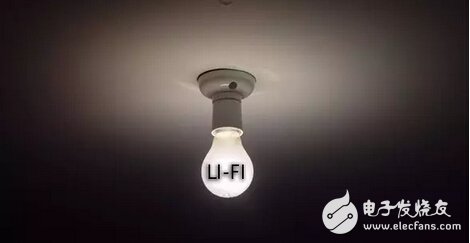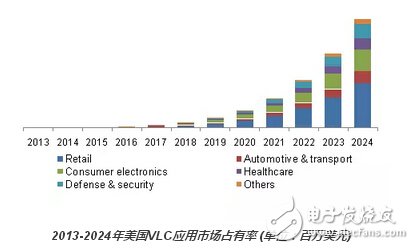The global visible light communication (VLC)/Li-Fi market is expected to reach $101.3 billion in 2024.
This is the research report data from the US market research company Grand ViewResearch. According to reports, higher illumination, longer life and lower power consumption make LED one of the components of the LI-FI system.
“Qian Jing†is so impressive, and naturally it has attracted many companies to “become eager to moveâ€. So, what is the current application trend?

Zhiku Jun now presents some general information about the development of this technology in the world, so that Zhiyou can learn more about the status quo in this field.

With LED lights, you can access the Internet, and the optical communication is positioned exactly cm.
Yao Mengming, general manager of the lighting design and application department of Philips Lighting China, believes that the application of optical communication positioning technology is an important part of the current intelligent lighting system.
It is reported that compared with the currently used wireless local area network (wireless LAN), the visible light communication system can use indoor lighting equipment instead of the wireless LAN local area network base station to transmit signals, and its communication speed can reach tens of megabits to hundreds of megabits per second, and the future transmission speed is still May exceed fiber optic communication. With a dedicated computer that can transmit and receive signals and a mobile information terminal, you can download and upload high-resolution images and animations for a long time as long as the indoor lights are illuminated.
There are many limitations to radio signal transmission equipment, which are rare, expensive, and inefficient. For example, mobile phones, millions of base stations around the world help them to enhance signals, but most of the energy is consumed by cooling, and the efficiency is only 5%. In contrast, the bulbs used in the world are inexhaustible, especially in the domestic LED light source is replacing the traditional incandescent lamps on a large scale. Simply add a microchip to any inconspicuous LED bulb to turn the bulb into a wireless network transmitter.
Yao Mengming said that without the need for WiFi signals, a single LED light can be used to access the Internet. This has become a reality and will become more popular in the future. According to its introduction, based on visible light communication technology, Philips Lighting has taken the lead in developing an optical communication indoor navigation and positioning system. Based on the network IP address and indoor physical address of the PoE luminaire, the strobe of the visible light of the LED, the visible light communication between the mobile phone camera and the LED light, and the APP, the use of the light for indoor positioning is achieved, and the accuracy can reach centimeters.
LED ceiling light or replace router, data transmission seconds up to 2GB
Recently, it has been reported that researchers at the King Abdullah University of Science and Technology (KAUST) in the Middle East have developed new nanocrystal materials that can turn blue light into white light. This achievement, in addition to giving people enough light, can make Wi-Fi speeds of up to 2GB per second. Although Wi-Fi and Bluetooth technologies have been widely used in information technology, if the wavelength of electromagnetic waves can be shortened, signal transmission will be improved.
Moreover, according to the researchers, if uncorrected electromagnetic waves are directly used for visible light communication (VLC), much energy will be saved in the future. VLC is a form of information transfer that combines lighting and visual technology. For example, an illuminated ceiling light can be used to connect to the network at the same time. The white light source of such VLC appliances currently needs to be provided by LEDs. However, producing them often requires combining a diode that originally emits blue light with a phosphor that emits red and green light. However, the speed at which the phosphor powder emits is far behind the speed at which the LED switch is turned on and off.
So the researchers made lead crystals of lead bromide, which is about 8 nanometers long, and introduced a conventional nitride phosphor in a very simple way. When the blue laser emits light, the nanocrystals and the nitride emit green light and red light at the same time, so that the three beams can be combined to emit white light. Researchers say that the optical properties of the new materials they study need to be characterized by femtosecond transient spectra.
At the same time, the researchers also showed that they have the ability to present the optical progression of lead bromide nanocrystals in just 7 nanoseconds. This also means that up to 491 MHz of optical radiation can also be modulated, which is 40 times faster than the addition of phosphor powder. In addition, the researchers also said that the speed of data transmission can theoretically reach 2GB per second. It is conceivable that as long as the computer storage capacity is large enough, with this speed, it is not afraid to download more HD movies or large games with larger files.
LightPointe New Company Develops First Highly Secure Data Communications Products
Recently, LightPointe, a designer and manufacturer of optical wireless products based on Free Space Optics (FSO) technology, announced the formation of a new company specializing in visible light communication and visible light wireless communication (LiFi) research. The newly formed company, FireflyWireless Networks, was formed after two years of incubation at LightPointe's R&D lab in San Diego.
Firefly's owners include LightPointe CommunicaTIons, venture capital firm Berg and BeryEnterprises, and telecom engineering company TeleconnectGmbH. Firefly has received patents in the field of visible light communication (VLC) and has developed the first highly secure data communication products.
VLC and LIFI technologies have recently received widespread attention to replace WiFi and RF communications; this is mainly due to the congestion of the WiFi and RF spectrum, and the vulnerability to interference and low reliability. By using a spectrum that is more than 10,000 times stronger than the RF spectrum, the communication process is almost impossible to intercept, thus avoiding the danger of network security and eavesdropping.
Zero.1 launches LiFi technology, providing unlimited possibilities for the Internet of Things
According to foreign media reports, the UAE technology company Zero.1 has already launched the visible light wireless communication (LiFi-LightFidelity) technology in Dubai. It is said that LiFi technology can turn Dubai's vision of “smart city†into reality and provide unlimited possibilities for the Internet of Things.
The Zero.1 R&D team also built a LiFiLED platform through its IOTA (Intelligent Outdoor Tower Automation) product line. IOTA will change the way public spaces and resources are managed. In a statement, Zero.1 stated that, coupled with the advanced City.1 software, the technology (LiFi) provides testing and management solutions for public spaces, community sites, industrial centers and commercial locations.
According to reports, LiFi hotspots can be provided in any private or public lighting, including street lights, and the same communication and sensor infrastructure can also monitor and control lighting and data. Among them, iOS and Android smartphones can be directly connected through LiFi technology, and short-range links can provide extremely high data speed and data security.
Apple targets visible light communication technology, iPhone 7 or LiFi?
Yesterday (August 30th), Apple officially issued an invitation letter to announce that it will officially hold a press conference at 10:00 am local time on September 7 (1 am Beijing time on September 8). The event will be held in Bill. · Graham Municipal Auditorium. The most popular concern of Volkswagen at this conference is the rumored flagship iPhone7. Looking back at the news at the beginning of this year, it is said that the launch of the next generation iPhone later this year seems to be testing LiFi visible light communication technology for the latest mobile phones.
It is reported that at the time, Twitter user Chase Fromm first found the word "LiFi capability" in the iOS9.1 software code, and the US technology blog AppleInsider subsequently confirmed. LiFi technology is considered a replacement for WiFi, and its inventor is University of Edinburgh professor Harald Haas. This technology uses the visible spectrum instead of the RF spectrum. In this system, the smart LED bulb will flash at an extremely fast rate, passing binary information. Such flicker is indistinguishable to the human eye.
In 2015, a startup that developed smart LiFiLED bulbs achieved a data transfer rate of up to 1GBps during testing. This means that users can download a high-definition movie in just a few seconds. However, the news also pointed out that LiFi technology is still in the early stages of development, and Apple's inclusion of such words in the code may be just for testing. Although the iPhone 7 may not eventually support this technology. However, this may mean that Apple is developing its own LiFi smart light bulb for use with other devices such as the iPhone, iPad, and AppleTV in the future. The results, we will wait and see next month at the next-generation Apple mobile phone conference.
Wewow gimbal has full series smartphone gimbal from one axis gimbal to two axis gimbal, Three Axis Gimbal.
- one axis gimbal: Fancy, S1, sport pro
- two axis gimbal: SP (won CEATECA digital awards in 2013)
- three axis gimbal: P3, Alite, A5, A1 legend
Wewow gimbal can fit with 95% smartphone in the market, such Samsung, iphone, Huawei, Xiaomi, HTC, etc.
Smartphone Gimbal,Handheld Smartphone Gimbal,Gimbal Stabilizer For Smartphone,Professional Smartphone Gimbal
GUANGZHOU WEWOW ELECTRONIC CO., LTD. , https://www.stabilizers.pl